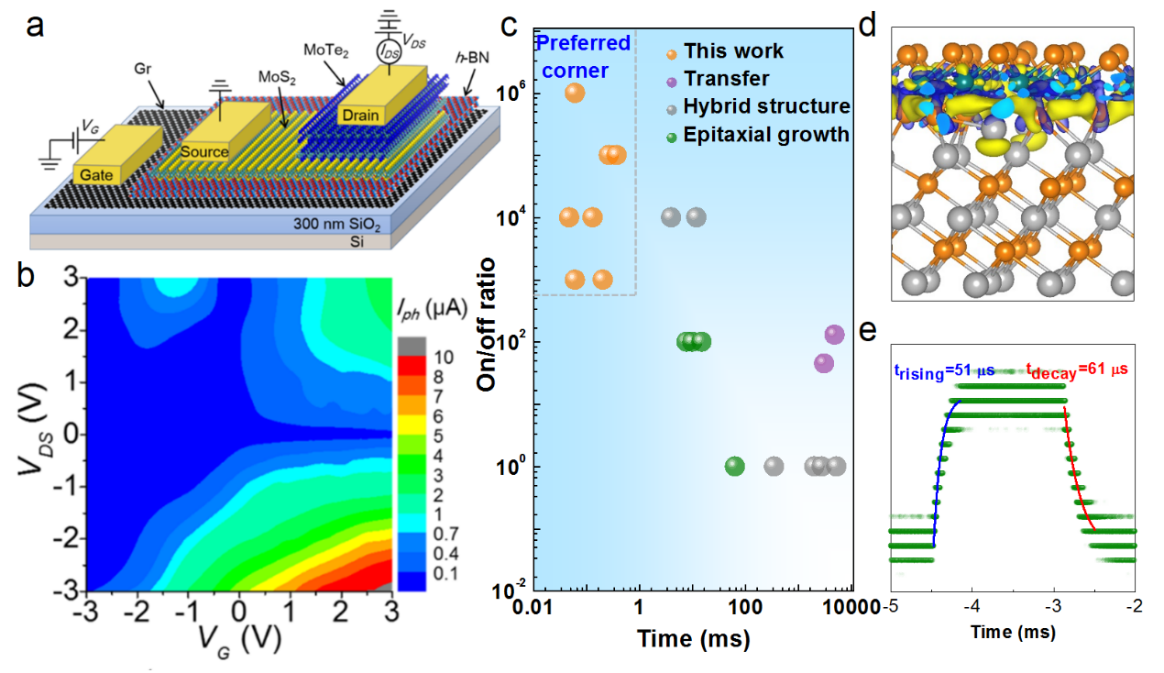Two-dimensional layered materials have attracted more and more attention from researchers because of their novel electronic/optoelectronic properties and high compatibility with silicon-based technologies. In addition, different two-dimensional materials can be stacked freely with the help of weak van der Waals force to form an artificial heterostructure with an atomic level flat interface. This heterostructure is usually called a van der Waals heterojunction. By choosing different two-dimensional materials and specific stacking methods, their unique properties can be organically combined. From this research perspective, van der Waals heterojunction provides a new platform to study the properties of new electronic and optoelectronic devices. Recently, He Jun’s research group successfully built asymmetric van der Waals heterojunction devices based on graphene, boron nitride, molybdenum disulfide, and molybdenum ditelluride, and systematically analyzed their electrical transport/photoelectric characteristics and storage capabilities. Research. Under different bias conditions, the charge carrier injection type can be switched between tunneling and thermal activation. This asymmetric transmission behavior has been further confirmed by the characterization of variable temperature and light response. Thanks to the great tunability of vertical transmission, the heterojunction device can be effectively adjusted by the external electric field and exhibit excellent performance in multiple functions at the same time. Many performance indicators are currently the highest reported in van der Waals heterojunction devices, including ultra-high current-on-off ratio (6×108) and obvious negative transconductance, as well as adjustable gate rectification characteristics. When the temperature is 300 K and 77 K, the current rectification ratio reaches 3×107 and 108, respectively. When working as a photodetector, the device exhibits high light responsivity (28.6 A/W) and optical switch ratio (107), as well as significant open-circuit voltage and short-circuit current. The research results were published online in Nature Electronics (Nature Electronics 2018, 1, 356-361) under the title "High-performance, multifunctional devices based on asymmetric van der Waals heterostructures". At the same time, "Nature Electronics" wrote News & Views with the title "Multifunctional devices from asymmetry" and made a special review of this work.
Van der Waals heterojunction has excellent photoelectric performance, but the tunneling barrier introduced by the van der Waals gap limits its application in photodetection. The van der Waals gap significantly increases the injection barrier of photo-generated carriers. A few days ago, He Jun's research team demonstrated a general strategy that can eliminate the van der Waals gap in the van der Waals heterojunction. He Jun's research group induced the vacancies of transition metal chalcogenides by annealing, and bridged the interface dangling bonds with non-layered chalcogenide semiconductors through strong orbital hybridization, thereby eliminating van der Waals in the van der Waals heterojunction. gap. The heterojunction device exhibits excellent photodetection performance. Many performance indicators are several orders of magnitude better than similar van der Waals heterojunction devices. For example, the bridged PbS/ReS2, PbS/MoSe2 and PbS/MoS2 exhibit ultra-fast light response speeds of 30μs, 51μs and 43μs, respectively. The bridged PbS The light-triggered on/off ratios of /MoS2 and ZnTe/MoS2 heterostructures exceed 106 and 105. Related research results have been published on Advanced Materials (Advanced Materials. 2020, 32, 1906874) under the title "Bridging the van der Waals interface for advanced optoelectronic devices".
The research work was supported by the national key basic research and development plan project funds.
Paper link:https://www.nature.com/articles/s41928-018-0086-0
https://onlinelibrary.wiley.com/doi/10.1002/adma.201906874

Structure diagram and photoelectric detection characteristics